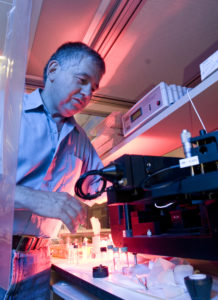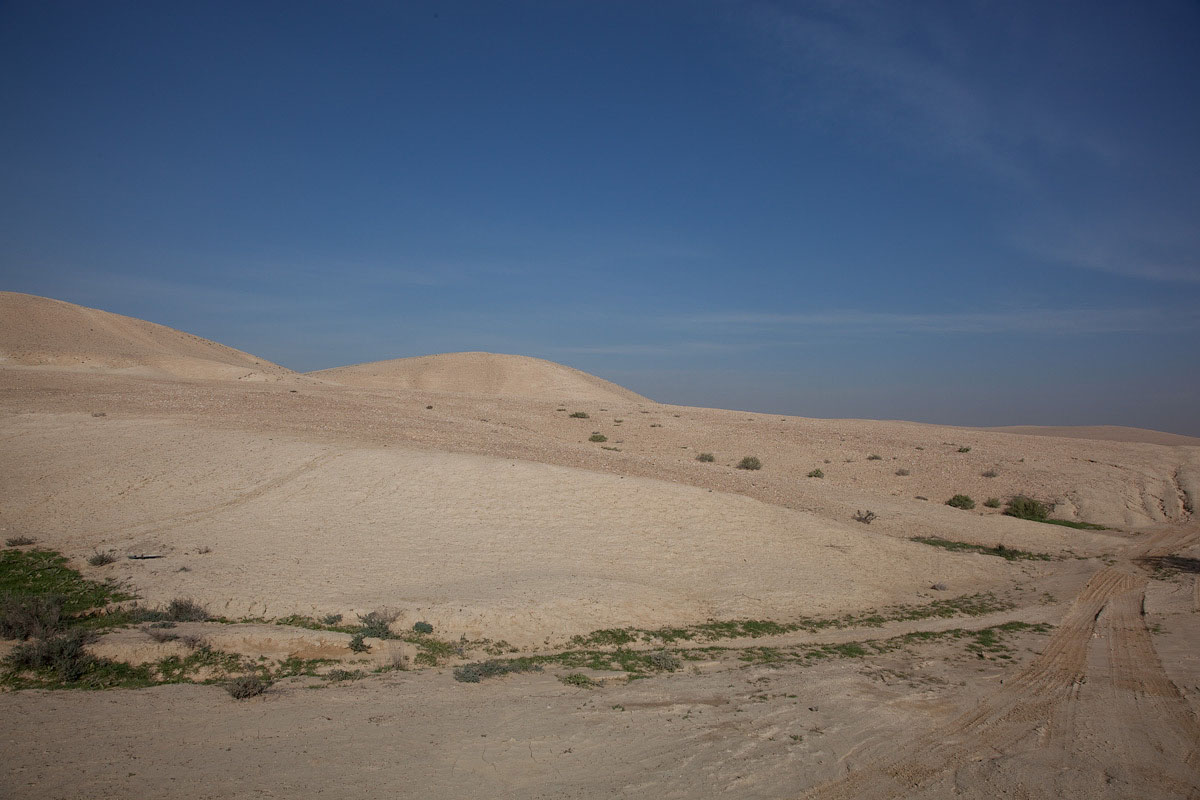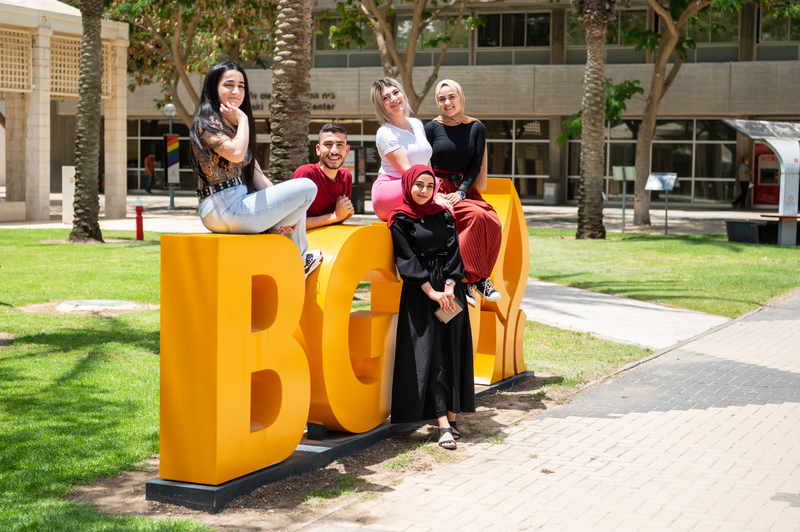
U. Chicago and BGU Form Water Alliance
U. Chicago and BGU Form Water Alliance
February 12, 2015
Desert & Water Research, Nanotechnology, Negev Development & Community Programs
The following feature article was published in the Chicago Tribune on Sunday, January 4, 2014. The photos used below are the property of BGU or Americans for Ben-Gurion University and are not the photos used in the original article.
Chicago Tribune — The Arava desert, a salty wasteland dotted with tufts of scrub, gets only about an inch of rain each year. And yet cows lazily low at dairy farms that collectively produce nearly 8 million gallons of milk annually. Orange bell peppers flourish in a long swath of greenhouses that skirts the Jordanian border. Kibbutzim with vineyards somehow manage to churn out shiraz and sauvignon blanc, unfazed by the desert sun.
The clusters of farms and wineries in the Arava are a testament to Israel’s acumen in water technology. One of the most parched places on Earth has found a way to beat water woes once so severe that Israel’s national mood rose and fell with the changing level of the Sea of Galilee, one of their most critical water sources.
That expertise helps explain why the University of Chicago sought out Israel’s Ben-Gurion University to help tackle one of the world’s most worrisome problems — water scarcity.
In decades past, oil used to be the commodity that shaped geopolitics, and at times, ignited wars. In coming years, water will be the commodity with that kind of clout.
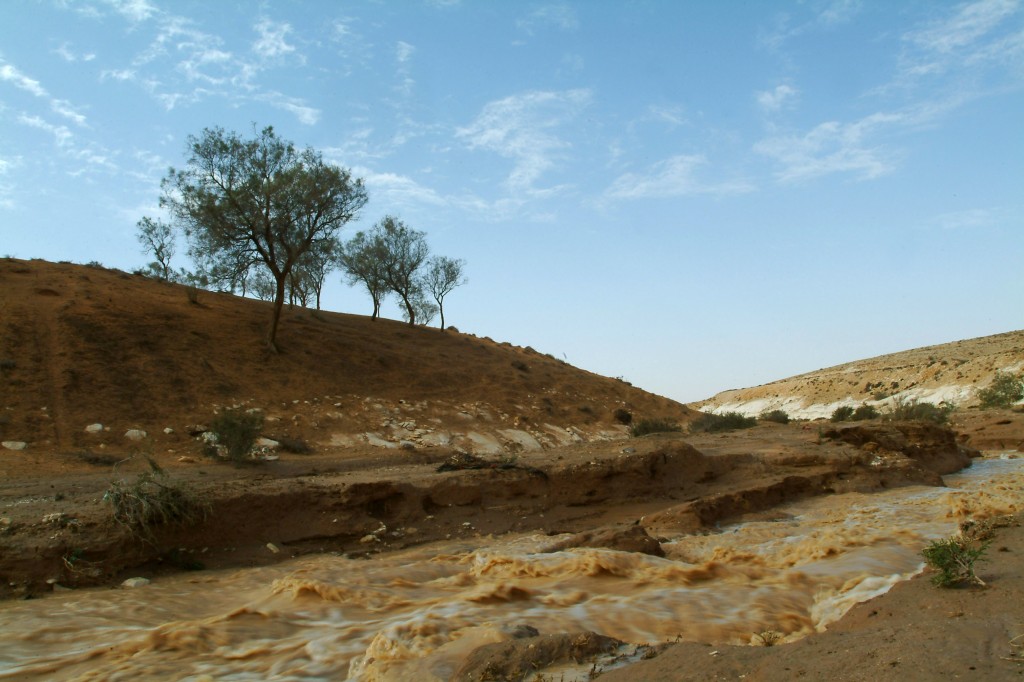
A desert wadi during a winter flood. The Negev desert gets on average only three inches of rainfall a year.
Water scarcity is no longer a problem buried in think tank monographs. It’s a crisis that has begun to have palpable, disturbing implications for much of the globe. By 2030, nearly half of the world’s population will be living in regions saddled with severe water stress, the UN projects. Over the last decade, the number of violent confrontations over water issues has risen fourfold, according to the Pacific Institute, a California-based think tank that studies global water scarcity.
The University of Chicago is tackling water scarcity because it believes it has a novel approach to the problem — relying on engineering at a molecular level to produce breakthroughs. The university opened its Institute of Molecular Engineering in 2011, and within a year talk began of putting water scarcity at the top of the institute’s agenda.
“There are shortages of water from the First World to the Third World,” said Steve Sibener, one of the University of Chicago scientists leading the research. “If you look at California, it has been a particularly dry year, and you can see how the whole West and Southwest can have boom and bust cycles that are likely to get worse. If you move onto the Middle East and Africa, you understand that water is precious — it’s like gold.
“It’s the issue of the day,” Sibener said. “Hundreds of millions of people are at risk of (not) having enough water.”
In laboratories in Chicago and the Israeli desert, scientists are crafting radical new approaches that may one day rejuvenate the world’s water-starved regions. One project uses a common inkjet printer to apply layers of chemicals to a water filter to repel bacteria and keep the filter clog-free. Another turns radioactive isotopes into tracking devices to trace water movement through aquifers, a development that could lead to the discovery of vast new strata of groundwater. Still another effort strives to create filtering membranes that operate on a molecular level, using electrically charged, cilia-like hairs to repel filter-fouling microbes. The goal is to complete research by the latter part of 2015.
Every experiment has representation from both the University of Chicago and BGU. The University of Chicago brings to the collaboration its expertise in molecular engineering, while BGU brings its experience of transforming water research into real-life applications in a water-starved nation.
For both universities, the collaboration represents an opportunity to parlay their top-shelf know-how into potential solutions for one of mankind’s most pressing priorities.
But for Chicago, the partnership could provide a cornerstone in the city’s bid to dramatically ramp up its global profile. When Mayor Rahm Emanuel traveled to Israel in June 2013 to announce the two universities’ collaboration, he spoke of the partnership as a steppingstone to Chicago’s eventual evolution into a water technology hub.
“He said he would like to see Chicago grow into a center for water technology,” said Prof. Moshe Gottlieb, BGU’s lead scientist for the collaboration, who joined Emanuel at the signing ceremony marking the collaboration. “I think this is a remarkable idea.”
If Chicago is serious, it will have to contend with Milwaukee, which has already forged a strong identity as a globally known magnet for water technology enterprise and research. The Milwaukee region is home to 150 water technology companies, as well as the nation’s first university-level freshwater sciences department at the University of Wisconsin at Milwaukee. Last year, the city christened the Global Water Center, an incubator that links water technology start-ups with larger corporations and academia.
“They’re exporting the creativity and solutions that those companies have to the rest of the world,” said Josh Ellis, a water policy expert at Chicago’s Metropolitan Planning Council. “They want to be this borderless global hub for ideas and innovation.”
Not safe to drink
Three quarters of the world is covered by water, but less than three percent is fresh water. More than 3.4 million people die each year of diseases related to lack of safe drinking water such as diarrhea — nine out of 10 of those deaths occur in developing countries. Water scarcity affects at least 700 million people in 43 countries, according to the UN. By 2025, the number of people living in areas without enough water will rise to 1.8 billion people, the UN states. Areas with annual water supplies below 1,000 cubic meters per person are regarded as water-scarce, according to the UN.
The quest to ensure reliable sources of drinking water has stoked discord among nations for millenia — and still does today.
In the Nile Valley, tension has ramped up over a dam the Ethiopians are building that would dramatically cut back the amount of water Egypt gets from the Nile for irrigation and drinking water purposes. In South Asia, the Pakistani government for years has accused India of building hydroelectric dams in the Indus Valley that rob Pakistan of water it needs for farm fields and human consumption.
Shortages can also spark violence. In the Bolivian city of Cochabamba in 2000, a 17-year-old teenager was killed and hundreds of people injured when the army stepped in to quell large protests over massive increases in water fees.

A graduate student researches desalination at BGU’s Zuckerberg Institute for Water Research.
Water crises aren’t limited to Asia and Africa. In Brazil’s largest city, Sao Paulo, more than half of residents said last fall that they had been hit with water shortages, and more than three-fourths of those affected said their water shut offs lasted more than six hours. The drought currently gripping Western U.S. states has robbed that region of 63 trillion gallons of water. The crisis is severe enough that Los Angeles Mayor Eric Garcetti in October set a city goal of reducing water use by 20 percent within the next two and a half years, and has warned that water restrictions will follow if the goal isn’t met.
The point man for the University of Chicago is Matthew Tirrell, a professor and founding director of the Institute for Molecular Engineering, who in 2012 approached Prof. Gottlieb, a longtime friend at BGU, about collaborating on water research. BGU was a logical choice, Prof. Tirrell said, because of the Israeli university’s reputation as a pioneer in water purification and desalination techniques “that are now really changing the water landscape of the country.”
From the start, the goal has been to nurture breakthroughs that can be global in scale.
“We need to look for things that are game-changers,” Prof. Gottlieb said. “We want to attack the issue at the molecular level. We want to take our expertise in nanotechnology, and put it to use in water-related problems.”
A water-starved place
Israel is the ideal place to turn to for water research expertise. Since its independence in 1948, Israel has had to find ways to build its society and economy in one of the most water-starved places on the planet. Its game plan for surmounting water scarcity had several pillars. It built a water supply line known as the National Water Carrier that transported water from the Sea of Galilee to the rest of the country, including the barren wastelands of the Negev and Arava deserts. It ingrained water conservation deep in the population’s mindset; for years, Israelis rationed their water use, and even as young children, they were taught to conserve.
“From the age of three, we learned to shut off the faucet while brushing our teeth,” said Udi Tirosh, business development director at IDE Technologies, an Israeli corporation that builds and operates desalination plants in Israel and around the world. “There was big demand control in Israel.”
The most significant initiative was Israel’s embracing of desalination technology. Israel built its first plant at Ashkelon on the Mediterranean coast in 2005 and now has five plants. Together, the plants produce 500 million cubic meters of water each year, about half of the country’s drinking water needs. In desalination, water is drawn out of the sea and then pumped through a series of filters to separate the brine and yield fresh water. Once desalinated, the water tastes like ordinary tap water.
“Desalination gives you the power to control your supply,” Prof. Tirosh said. “Up until a few decades ago, you were waiting for rain or digging a well. Now that you can desalinate, it’s game-changing. You can produce efficient water from the sea, which is important because rivers can dry out, and lakes and aquifers can dry out. This is what happened in Israel.”
There are now more than 17,000 desalination plants in 150 countries, and expanded use of the technology could drastically ratchet up water supplies for water-starved nations. But desalination isn’t problem-free. The bane of desalination plants is biofouling, the buildup of microbes on filter surfaces. It makes an already costly approach to creating drinking water even costlier.
A portion of the BGU/University of Chicago research targets the world’s increasing reliance on desalination. The goal, Prof. Tirrell said, is to create new technology that solves the problem of bio-fouling, and in doing so, make desalination more practical across the globe. To that end, Prof. Tirrell and his Israeli counterparts are creating new strandlike molecules less than one-10,000th of the diameter of a human hair, and attaching those strands to the surface of a desalination filter. The strands are electrically charged both positively and negatively, and that combination repels bacteria. “No one really knows why,” Prof. Tirrell said.
“It’s important to have widespread use of desalination, so it’s important to bring the cost down,” Prof. Tirrell said. “The potential of this research is to have very long-lasting membranes where the cost of the membranes comes down by a factor of two.”
BGU’s role in Prof. Tirrell’s project is to find a way to ramp up the scale of production of the strand-covered filters. Prof. Tirrell’s team can only make “on a good day, a square centimeter. [But] you have to make it in square meters. That’s why Israel has been brought in.”
At BGU’s Sde Boker campus [home to the Jacob Blaustein Institutes for Desert Research] in the heart of the Negev desert, biological chemist Dr. Christopher Arnusch is relying on an everyday office mainstay — the inkjet printer — to help improve water filtration. Dr. Arnusch has found a way to use the printers to apply anti-bacterial coatings to filters, a breakthrough that allows scientists to economically affix the right mix of chemicals to sheets of filters a meter wide.
“When you get this slimy, bacterial material on membranes, it makes them ineffective and reduces their shelf life,” Dr. Arnusch said. “And it costs more energy to run the systems.”
Dr. Arnusch and Prof. Tirrell focus on water purification. Another BGU scientist, Prof. Eilon Adar, has a very different mission — finding new sources of water.
With technology developed at Argonne National Laboratory outside Chicago, Prof. Adar and his team use naturally occurring radioactive isotopes to track the movement of groundwater through aquifers as deep a mile below the surface, relying on a special laser device to detect the number of krypton isotopes in a water sample. Krypton isotopes are used because they begin to decay once they move from surface water to underground strata. The number of isotopes found tells scientists how long the water has been underground. With that information, they can plot the oldest to youngest samples on a map and determine the water’s flow through the aquifer, and ultimately the aquifer’s size and characteristics.
Prof. Adar says the research has an intriguing practical application — finding water in the bedrock beneath the world’s deserts.
“You cannot sustain a growing population with diminishing amounts of water,” Prof. Adar says. “So we move into arid and semi-arid basins. … And we all know that,under deserts around the world there are huge groundwater reservoirs.”
“[Moammar] Gadhafi, no matter how crazy he was, he drilled for oil but also found water under the Sahara,” says Prof. Adar, referring to Libya’s longtime former leader. “He was the first one to divert water from the desert to the coastal plain of the Mediterranean. He called it at the time the ‘Grand Manmade River.’ He was crazy but he did something very logical. It is brackish, somewhat saline, but by one order of magnitude fresher than sea water. Why treat sea water if you can treat brackish groundwater? And Libya didn’t suffer from lack of energy, so it made sense.”
A wellspring of research
Prof. Adar’s research can also help in Israel, where desert enterprises — from dairy farms to wineries to fish hatcheries — distill their struggles into a single, common plight: lack of water.
Israel’s evolution as a wellspring for water technology know-how explains why farms in the Arava thrive. Israel is the birthplace of drip irrigation technology, which conserves by delivering a trickle of water directly to plant roots. Israeli researchers also have fine-tuned how much pure water needs to be added to brackish water drawn from Arava aquifers in order for a given plant species to thrive.
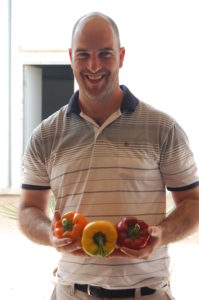
Dr. Naftali Lazarovitch, of BGU’s Wyler Department for Dryland Agriculture, cultivates sweet peppers with a combination of desalinated and saline water in the Arava.
Today, farmers in the Arava grow almost everything found in the nation’s grocery store produce sections: mangoes, pomegranates, grapes, watermelons, tomatoes, potatoes, corn, bell peppers and eggplants.
At a kibbutz farm in Samar, the challenge is to keep from overheating dairy cows, livestock that normally would not survive in a desert climate. The solution — showers, seven times a day during summer months, and three or four times a day during the rest of the year.
The wineries of the Arava and Negev face their own daunting obstacles: water and soil that’s too saline, a desert sun that bakes vines with temperatures above 110 degrees during harvest time.
And yet, at Kibbutz Neot Semadar, a winery in the southern end of the Arava desert, an oasis blooms. Gardens of lavender line pools filled with large goldfish. Orchards yield apricots, almonds, apples and plums. And despite the climate, the shirazes, merlots and chardonnays hold up well, locals say.
“Over time, Israel’s farmers have become extremely efficient at using water,” says Prof. Jack Gilron, a leading scientist at BGU’s Zuckerberg Institute for Water Research in Sde Boker. “For them, water’s scarcity became the spur for how to do water more efficiently. Drip irrigation is now a leading export, and it comes out of this concern about how do make sure water is used to the utmost efficiency.”
That resourcefulness, said Sibener, makes Israel the ideal partner for a collaboration that tackles a global dilemma as weighty as water scarcity.
“They are a natural partner,” he said. “Water is scarce, and a lot of the politics are complicated. Out of necessity, they have had to develop as a national initiative the ability to be independent in their water consumption. And they’ve achieved that goal. Now they’re sharing that technology with the rest of the world.”


